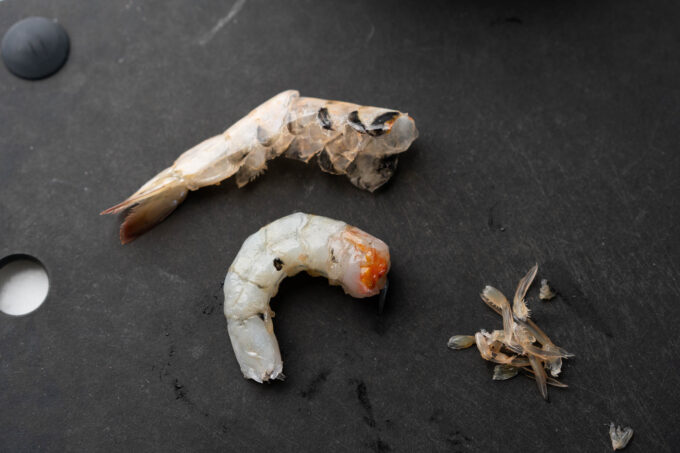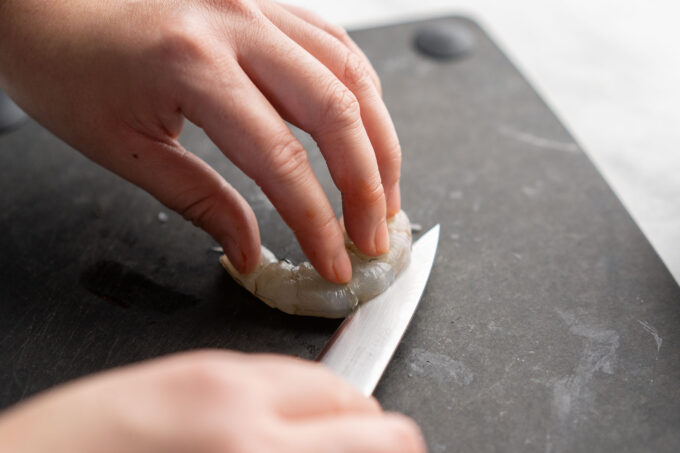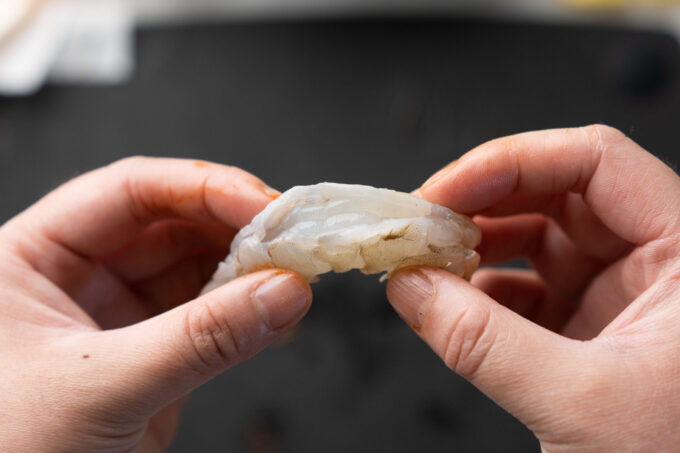Are you going to cook shrimp and want to know how to peel and devein them the right way? Some people might say you don’t even need to devein them, but we already know what we want to do, right?
You can clean shrimp quickly and devein them with or without shells. My mom taught me a really quick way to do it.
Shrimp are a delicious and versatile seafood, but preparing them can be tricky Many recipes call for peeled, deveined shrimp However, keeping the shell on during cooking can actually enhance flavor and moisture. If you want to keep that shell intact, proper cleaning is essential to remove grit and bacteria without damaging the delicate meat.
In this comprehensive guide, I’ll explain how to clean shrimp without removing the shell You’ll learn
- Why cooking shrimp in the shell can boost flavor
- Step-by-step instructions for cleaning shell-on shrimp
- Pro tips for getting shrimp ultra-clean
- How long to store shell-on shrimp
- The best cooking methods for shell-on shrimp
After reading, you’ll be a pro at preparing shrimp with the shell on! Let’s get started.
Why Cook Shrimp in the Shell?
I used to always peel my shrimp before cooking. The shell just seemed like an annoying extra step. However, once I tried recipes like grilled shrimp or shrimp boil with the shells on, I realized what I had been missing out on!
Here are some benefits of cooking shrimp in the shell:
-
Flavors stay locked in. The shell protects the shrimp’s natural juices and seasonings from leaking out into the cooking liquid.
-
Textural contrast. You get a delightful crunch from the shell against the tender interior meat.
-
Easier handling. The shell helps the fragile shrimp hold its shape during cooking.
-
Visual appeal. Shells add beautiful color to shrimp dishes.
But to reap those benefits, you need to clean the shrimp properly. Removing the vein and grit without damaging the meat can be tricky. Here’s how to do it right.
How to Clean Shrimp Without Removing the Shell
Follow these steps to clean shrimp like a professional:
Step 1: Rinse the Shrimp
Give shrimp a good rinse under cold, running water. This removes any debris and dirt clinging to the shell exterior.
![Rinsing raw shrimp under running water][]
Rinse shrimp before cleaning to remove surface debris. Image credit: Shuttestock
Step 2: Cut Along the Back
Use a small, sharp knife or kitchen shears to make a shallow incision along the back of the shrimp. Cut just deep enough to expose the vein.![Cutting along back of shrimp][]
Make a shallow cut along the shrimp’s back to expose the vein. Video credit: YouTube
Be gentle. You don’t want to slice all the way through the shell into the meat.
Step 3. Remove the Vein
Use the tip of the knife or shears to gently remove the vein. Try to keep the cut intact so you don’t tear the shell.![Removing vein from shrimp][]
Carefully remove the vein without damaging the shell. Image credit: Shutterstock
Discard the veins or save them to make shrimp stock.
Step 4. Rinse Again
Give shrimp one final cold water rinse to wash away any residue. Then pat dry with paper towels.![Rinsing shrimp after deveining][]
Rinse cleaned shrimp before cooking or storing. Image credit: Shutterstock
And that’s it! Your shrimp are ready for cooking.
Pro Tips for Ultra-Clean Shrimp
For pristine shell-on shrimp, try these extra steps:
- Use a scrub brush. Gently scrub the shells with a small brush to dislodge any clinging debris.
- Soak in saltwater. Dissolve 2 tbsp salt per 1 quart cold water. Soak shrimp for 30 minutes to draw out impurities.
- Devein with floss. For a precise, undamaged cut, try using unwaxed dental floss to slice the vein out.
- Dry thoroughly. Pat shrimp very dry before cooking. Excess moisture can make the shell slimy.
Put in the extra work to get shrimp squeaky clean. It will pay off in terms of flavor and food safety.
Storing Shell-On Shrimp
Handle raw shell-on shrimp just like you would peeled shrimp:
- Place shrimp in an airtight container or resealable plastic bag.
- Store in the coldest part of the refrigerator, 35-38°F.
- Use within 1-2 days for peak freshness. The shell can start to get slimy over time.
- You can also freeze shell-on shrimp for longer storage.
The shell helps slow down spoilage but doesn’t make shrimp last forever. Use good food safety practices.
The Best Cooking Methods
You can use shell-on shrimp in any recipe that calls for peeled shrimp. But certain cooking methods really highlight the flavor and textural benefits.
Try grilling, broiling, boiling, or pan searing. The dry heat helps caramelize and crisp the shell while steaming the meat inside.![Grilled shrimp with shell][]
Grilling is an ideal cooking method for shrimp with shells. Image credit: ChefsResource
For sauteing, stir fries, and other wet-cooking methods, peel away part of the shell to allow seasonings to penetrate. Leave the last tail segment with shell intact.
However you cook them, shell-on shrimp deliver big flavor and visual impact. Once you try them, you may never go back to plain old peeled shrimp!
So don’t be intimidated by the shell. With proper cleaning and cooking, you can enjoy the full benefits that shell-on shrimp have to offer. Dig in and savor the crunch.

Is it necessary to devein shrimp?
I personally grew up eating cooked shrimp that wasn’t deveined, and I honestly couldn’t tell the difference. If you’re going to cook the shrimp and don’t mind the intestinal vein, you don’t have to take it out.
I typically don’t bother to devein smaller or medium-sized shrimp. Some chefs like to take the veins out of jumbo or large shrimp because the veins can be bigger and make the texture sandier or grittier. Also, take it off if you want to eat the shrimp raw for nigiri or sashimi so it doesn’t have a gritty texture or a bitter taste.
How to devein shrimp without shell (w/ a knife)
It’s easier to devein shrimp that don’t have shells because you don’t have to work with a hard shell. The easiest way to devein shrimp without shells is using a knife, and it’s the most common method.

1. After you’ve removed the head and shell, lay your shrimp on its side.

2. Depending on the size of the shrimp, make a shallow cut (about ⅛ to ¼-inch deep) along the back of the shrimp, from the tail to the head. The slit only needs to reach where the intestinal vein lives.

3. Remove the tract and clean the shrimp in a bowl of water or running water.
How to Devein Shell-On Shrimp Tutorial Video
How do you de-vein shrimp without removing the shell?
Here’s how to de-vein shrimp without actually removing the shell: Snip up the back of the shell with cooking shears, just deep enough into the meat to reveal the “vein”. Pull the vein out of the shrimp through the cut in the shell. Rinse out the shrimp where the vein used to be.
Can I eat raw shrimp?
Eating raw shrimp is not recommended. Raw shrimp can contain bacteria that can cause food poisoning. It is also a good source of purines, which can trigger gout attacks. If you want to eat shrimp, cook it thoroughly to reduce the risk of food poisoning and to help prevent gout attacks. Cook shrimp until it is opaque and pink to ensure that it is safe to eat.
How do you clean shrimp?
You can check out five different ways to clean shrimp in the video below. Head on shrimp/prawn, cut along the “spine” to devein. Head on shrimp/prawn, deveined using a toothpick (i.e. not cut along the “spine”). Head off shrimp/prawn, deveined with shrimp shell. Head off shrimp/prawn, deveined with shrimp shell off, tail on.
How to peel shrimp without shells?
Without the shells, it’s much easier to cut or pierce through the meat or even visibly see where the vein is located. Here is how to peel shrimp with your hands: Option to remove the head. Twist and pull the head off completely. Pull off the legs.
